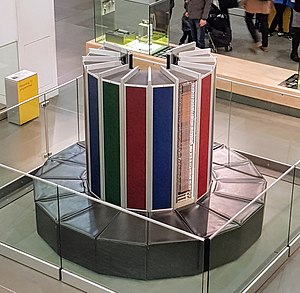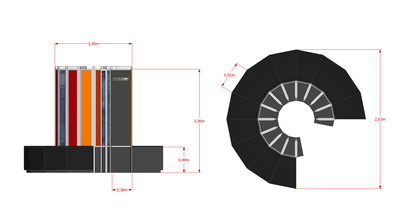| Cray-1 | |
|---|---|
 A Cray-1 on display at the Science Museum in London | |
| Design | |
| Manufacturer | Cray Research |
| Designer | Seymour Cray |
| Release date | 1975 |
| Units sold | Over 100 |
| Price | US$7.9 million in 1977 (equivalent to $39.7 million in 2023) |
| Casing | |
| Dimensions | Height: 196 cm (77 in)[1] Dia. (base): 263 cm (104 in)[1] Dia. (columns): 145 cm (57 in)[1] |
| Weight | 5.5 tons (Cray-1A) |
| Power | 115 kW @ 208 V 400 Hz[1] |
| System | |
| Front-end | Data General Eclipse |
| Operating system | COS & UNICOS |
| CPU | 64-bit processor @ 80 MHz[1] |
| Memory | 8.39 Megabytes (up to 1 048 576 words)[1] |
| Storage | 303 Megabytes (DD19 Unit)[1] |
| FLOPS | 160 MFLOPS |
| Successor | Cray X-MP |

The Cray-1 was a supercomputer designed, manufactured and marketed by Cray Research. Announced in 1975, the first Cray-1 system was installed at Los Alamos National Laboratory in 1976. Eventually, eighty Cray-1s were sold, making it one of the most successful supercomputers in history. It is perhaps best known for its unique shape, a relatively small C-shaped cabinet with a ring of benches around the outside covering the power supplies and the cooling system.
The Cray-1 was the first supercomputer to successfully implement the vector processor design. These systems improve the performance of math operations by arranging memory and registers to quickly perform a single operation on a large set of data. Previous systems like the CDC STAR-100 and ASC had implemented these concepts but did so in a way that seriously limited their performance. The Cray-1 addressed these problems and produced a machine that ran several times faster than any similar design.
The Cray-1's architect was Seymour Cray; the chief engineer was Cray Research co-founder Lester Davis.[2] They would go on to design several new machines using the same basic concepts, and retained the performance crown into the 1990s.

- ^ a b c d e f g Cray-1 Computer System Hardware Reference Manual 2240004, Rev C, Publication: 1977 November 4, Cray Research, Inc.
- ^ C.J. Murray, "The ultimate team player," Archived October 28, 2008, at the Wayback Machine Design News, March 6, 1995.